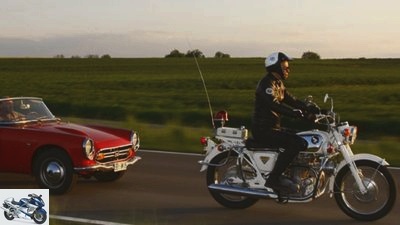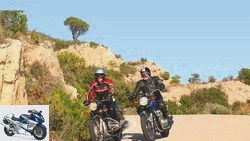Menus

wolf
Scene: Honda CB 450 Police
Highway – too fast
Content of
American nightmare? Encounter of the miraculous kind? A US Honda CB 450 police machine appeared in the rearview mirror and flashed in front of me. Where was I actually? And what had I done?
It could have been on Interstate 80 in 1972. Behind Cheyenne, Wyoming’s capital. Destination Laramie, why not? Empty, large plains, as always at such an early hour in this US state. The Honda S 800 is in good shape, warm, can and may be turned. 9000 rpm in third gear allow a smooth transition to fourth. 65 mph is quickly exceeded – the few miles over, so what? But the devil saw it, in the form of a law enforcement officer on a Honda CB 450. The S 800 has no chance, the siren gets louder, red lights flicker closer and past: State Police. The white Honda sits down in front of the red one, slowing down the fun.
The reality writes in 2008, the setting is the area around Tubingen. Only the Honda S 800, built in 1967, and the Honda CB 450, which started work for the police in the US state of Wyoming in 1971, are real. It belongs to Stefan Hauch, the specialist when it comes to CB 450 – which alleviates the astonishment that he has such a thing in his collection. Original Police-CB 450 are really very, very rare because they were very rare in 1971.
As early as 1965, shortly after the appearance of the CB 450, Honda tried to do business with the American authorities: around 25 "Police specials" based on the first CB, called Black Bomber, went across the pond and into the fleet of the executive branch. It didn’t turn out to be a business. Honda tried it again in 1971, this time on the basis of the CB 450 K1, i.e. with five instead of four gears and 45 hp instead of 43. Between 300 and 400 copies made it into government service, one of which is Hauch’s machine. Again, no major deal came off.
The reason for the failure of Japanese motorcycles – other manufacturers also wanted to participate – was called Harley-Davidson. Many American patrolmen would probably have licked their fingers after one of the handy Honda CB 450s, since they would have been something like the Speed King on highways and interstates with a top speed of almost 170 km / h; to do so easily on the go. The Japanese twin was no comparison to the heavy, aged Harley construction with the license to be detached. But of course: US authorities should buy US goods, understandably. Just imagine the outcry by German politicians if the police in this country had wanted to drive a Honda instead of a BMW in the 1960s.
In any case, the Honda entered service in 1971 and provided it until 1977. Then it was retired, but not repainted as a private machine like at least 90 percent of its female colleagues. Outwardly untouched and with about 10,000 miles on the counter, she simply stopped and ended up miraculously in Holland, where Stefan Hauch released her from her slumber two years ago. What happened to her then was very pleasant: All the paintwork was given fresh paint, the rest he worked on. The engine remained untouched – to this day.
Technology and equipment
wolf
Honda CB 450 Police.
The Honda still starts at the first push of a button as it did in its first days, quickly lapses into a stable idle and typically grumbles – just like a CB 450. Typically the willing rev up to what feels like 8000 rpm – a rev counter is missing. But also the chassis: the suspension hard, the damping weak, that was the Japanese beginning. The brakes are okay, the 170 km / h top speed comes with little vibration; The Harley couldn’t even come close to offering Bourbon to such a device. In any case, typically Japanese and typically Honda: A CB 450 is still a strong statement today.
This model looks a bit clumsy, but that’s due to the police ingredients, which cause an additional weight of an estimated 20 kilograms. Total weight about 220 kg, a lot of wood for a not fully poured 500, but acceptable for performance for which other manufacturers needed 750 cc. The engine corresponds 100 percent to the K1 series, as does the frame, except for two welded struts to strengthen the rear end.
The footrest extensions are also intended for reinforcement, they come from the Scrambler sister model. The rear crash bars are specially designed for the police model, the front ones were also designed for the civil Hondas. Here just now with brackets for the two red lights and the horn, which drives the rear wheel via a friction roller, a lever on the left of the handlebar creates the frictional connection. A sound to fear, and of course: the faster, the louder. An additional flywheel rotates in the smooth-running mechanics, so that the Jericho attack only comes to rest after about two minutes, even when standing still. The civil K1 already had two separate instruments, on the Police CB there is only one speedometer in the lamp pot. It’s big and can be calibrated, a button on the left switch unit freezes the needle, a second press releases it again.
Another additional button on the right-hand side of the handlebars starts the light show. Its rear rotating light is not even uniform in police equipment: each state could let its own wishes shine. The white lunch box at the back was an optional extra that was only available upon express request. Inside is the switch for the lamp attached to it, and behind it is a notepad, i.e. a ticket holder. In this way, the cop could properly punish traffic violations even during nightly controls. What went into the box was in turn left to the officials in the states: Whopper, BigMac, two-way radio or weapons. The latter are actually not necessary; it is enough to turn on the siren. Because it really requires a gun license, whether in Wyoming or Swabia.

motorcycles
On the move: BMW R 75/5, Honda CB 750
The summer of 69
read more
Related articles
-
Honda CB 1100 R, Honda VF 1000 R in the test
Jahn 16 pictures Jahn 1/16 athletes in tails – the two long-distance racers from the Honda brand in comparison. Jahn 2/16 Very fine detail, from racing …
-
Comparison test Ducati 996 S, Honda CBR 900 RR, Triumph Daytona 955i
PhotoGargolov comparison test Ducati 996 S, Honda CBR 900 RR, Triumph Daytona 955i Strategy games Four wins? Or would you rather be quick with three? …
-
On the move with the Honda CBX 550 F2
Fred Siemer, Archive, Honda 18 pictures Fred Siemer, Archive, Honda 1/18 On the move with the Honda CBX 550 F2. Fred Siemer, Archive, Honda 2/18 The Honda …
-
factstudio.de 15 pictures factstudio.de 1/15 Honda CB 1000 R + in the top test. factstudio.de 2/15 The design line of the new CB 1000 R is called “Neo Sport Cafe” ….
-
Driving report Honda CBR 1100 XX
Driving report, Honda CBR 1100 XX Blackbird Honda CBR 1100 XX There has been a lot of speculation in the past few weeks. Is the Honda CBR 1100 XX really…
-
Driving report Honda CRF 1000 L Africa Twin (part 1)
Honda 13 photos ULA SERRA PRATS 1/13 Honda Africa Twin. 2/13 270 degree crank pin offset, long, continuous shaft with two balance weights in front of the…
-
Innovations 2019 Top topic Honda Honda CB 650 R (2019) in the driving report Middle-class four-cylinder in Neo Sports Cafe design At the Paris Motor Show, …
-
On the move with Honda CB 1100 F and Kawasaki GPZ 1100 B2
www.factstudio.de 29 pictures factstudio.de 1/29 picture gallery: Honda CB 1100 F and Kawasaki GPZ 1100 B2 on the move. factstudio.de 2/29 Honda CB 1100 F and …
-
Test: Honda X4 Eminence Gray The new Honda X4 muscle bike is threatened with a fate similar to that of the Yamaha Vmax: It should only be sold via the gray …
-
Test Honda VTR 1000 V-Lenz Spring is all about the new two-cylinder. The focus of the action: Honda’s VTR 1000 F. You don’t like it …